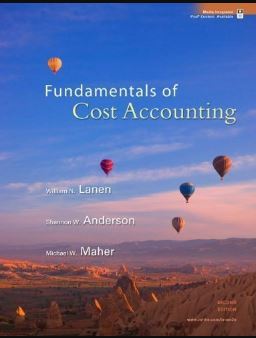
Fundamentals of Cost Accounting 2nd Edition by William Lanen, Carolyn Wells, Michael Maher
Edition 2ISBN: 978-0077274993
Fundamentals of Cost Accounting 2nd Edition by William Lanen, Carolyn Wells, Michael Maher
Edition 2ISBN: 978-0077274993 Exercise 5
Activity-Based Costing and Predetermined Overhead Allocation Rates
Kitchen Supply, Inc. (KSI), manufactures three types of flatware: institutional, standard, and silver. It applies all indirect costs according to a predetermined rate based on direct labor-hours. A consultant recently suggested that the company switch to an activity-based costing system and prepared the following cost estimates for Year 2 for the recommended cost drivers.

In addition, management estimated 7,500 direct labor-hours for Year 2.
Assume that the following cost driver volumes occurred in January Year 2:

Actual labor costs were $15 per hour.
Required
a. Compute a predetermined overhead rate for Year 2 for each cost driver using the estimated costs and estimated cost driver units prepared by the consultant. Also compute a predetermined rate for Year 2 using direct labor-hours as the allocation base.
b. Compute the production costs for each product for January using direct labor-hours as the allocation base and the predetermined rate computed in requirement ( a ).
c. Compute the production costs for each product for January using the cost drivers recommended by the consultant and the predetermined rates computed in requirement ( a ). ( Note: Do not assume that total overhead applied to products in January will be the same for activity-based costing as it was for the labor-hour-based allocation.)d. Management has seen your numbers and wants an explanation for the discrepancy between the product costs using direct labor-hours as the allocation base and the product costs using activity-based costing. Write a brief response to management.
Kitchen Supply, Inc. (KSI), manufactures three types of flatware: institutional, standard, and silver. It applies all indirect costs according to a predetermined rate based on direct labor-hours. A consultant recently suggested that the company switch to an activity-based costing system and prepared the following cost estimates for Year 2 for the recommended cost drivers.

In addition, management estimated 7,500 direct labor-hours for Year 2.
Assume that the following cost driver volumes occurred in January Year 2:

Actual labor costs were $15 per hour.
Required
a. Compute a predetermined overhead rate for Year 2 for each cost driver using the estimated costs and estimated cost driver units prepared by the consultant. Also compute a predetermined rate for Year 2 using direct labor-hours as the allocation base.
b. Compute the production costs for each product for January using direct labor-hours as the allocation base and the predetermined rate computed in requirement ( a ).
c. Compute the production costs for each product for January using the cost drivers recommended by the consultant and the predetermined rates computed in requirement ( a ). ( Note: Do not assume that total overhead applied to products in January will be the same for activity-based costing as it was for the labor-hour-based allocation.)d. Management has seen your numbers and wants an explanation for the discrepancy between the product costs using direct labor-hours as the allocation base and the product costs using activity-based costing. Write a brief response to management.
Explanation
Activity based Costing: Activity based c...
Fundamentals of Cost Accounting 2nd Edition by William Lanen, Carolyn Wells, Michael Maher
Why don’t you like this exercise?
Other Minimum 8 character and maximum 255 character
Character 255


